
A webinar by David Mellor of the Center for Open Science.
- Subject:
- Biology
- Life Science
- Material Type:
- Interactive
- Provider:
- Center for Open Science
- Author:
- David Mellor
- Date Added:
- 11/30/2021

A webinar by David Mellor of the Center for Open Science.

This paper presents real-world data, a problem statement, and discussion of a common approach to modeling that data, including student responses. In particular, we provide time-series data on the number of boys bedridden due to an outbreak of influenza at an English boarding school and ask students to build a mathematical model, either discrete or continuous, of this epidemic, and to estimate the parameters in their model and validate it against the data. Students will need access to a computer or computer lab with spreadsheet software, a computer algebra system, or a sufficient statistical analysis system such as R.

This video lesson shows students that math can play a role in understanding how an infectious disease spreads and how it can be controlled. During this lesson, students will see and use both deterministic and probabilistic models and will learn by doing through role-playing exercises. The primary exercises between video segments of this lesson are class-intensive simulation games in which members of the class 'infect' each other under alternative math modeling assumptions about disease progression. Also there is an occasional class discussion and local discussion with nearby classmates.
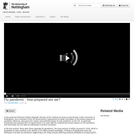
In this podcast Professor Robert Dingwall, Director of the 'Institute of Science and Society' at the University of Nottingham, and a member of the UK government’s Department of Heath committee on the ethical aspects of pandemic influenza, discusses the causes and potential impact of a flu pandemic on the UK. In particular, examining how prepared the UK government is to cope with the medical and social impacts of a flu pandemic, and what steps we can take as individuals to protect ourselves.
In the last century, there were three separate flu pandemics, the most serious of which occurred in 1918, which is estimated to have resulted in the deaths of 50 million people worldwide. Professor Dingwall discusses the likelihood of another flu pandemic happening in the future and the differing methods available for protecting the population. He also discusses how a flu pandemic could be defeated, emphasising the importance of the role of the wider community and personal responsibility. Professor Dingwall also discusses the potential impact of a flu pandemic on the workplace, in particular health care professionals and the conflicting responsibilities to themselves, their families and their jobs.
How prepared are we in the UK for the potential impact of a flu pandemic?
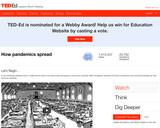
In our increasingly globalized world, a single infected person can board a plane and spread a virus across continents. Mark Honigsbaum describes the history of pandemics and how that knowledge can help halt future outbreaks. A quiz, thought provoking question, and links for further study are provided to create a lesson around the 8-minute video. Educators may use the platform to easily "Flip" or create their own lesson for use with their students of any age or level.

This resource is a video abstract of a research paper created by Research Square on behalf of its authors. It provides a synopsis that's easy to understand, and can be used to introduce the topics it covers to students, researchers, and the general public. The video's transcript is also provided in full, with a portion provided below for preview:
"Influenza infection can be tough to fight on its own, but secondary bacterial infections can make influenza even more serious, especially among elderly and immunocompromised individuals. These bacteria have the potential to become antibiotic resistant, making treatment even more complicated. Unfortunately, the expression of antibiotic resistance genes (ARGs) by microbes in the respiratory tract is not well understood. A recent study sought to characterize ARG expression in microbes during influenza infection. Researchers evaluated nasal swab samples and blood samples from 37 influenza-infected patients. Sequencing revealed that ARG expression was particularly common in S. aureus and S. pneumoniae species in the airway, and host transcriptome profiling identified several host key regulators involved in the influenza response, suggesting that the respiratory tract may be an important reservoir of ARGs in humans..."
The rest of the transcript, along with a link to the research itself, is available on the resource itself.

This resource is a video abstract of a research paper created by Research Square on behalf of its authors. It provides a synopsis that's easy to understand, and can be used to introduce the topics it covers to students, researchers, and the general public. The video's transcript is also provided in full, with a portion provided below for preview:
"A new vaccine against influenza virus may offer previously unattainable levels of protection to newborn pigs. Just as humans muddle through the flu season each year, pigs across the globe are affected by their own regular outbreaks, causing notable economic losses in the pork industry. But an international research team has now shown that the newly developed vaccine can keep the virus from replicating in newborn pigs, potentially reducing the spread of disease. Historically, breeding females have been the main target for influenza control in pig populations. Females given a vaccine containing an inactive form of influenza type A virus – a key agent of respiratory disease in pigs – can confer passive immunity to their offspring. But this doesn’t stop piglets from becoming infected with or passing on the virus – it just keeps them from showing clinical signs for a short period, since any maternally derived protection will wear off over time..."
The rest of the transcript, along with a link to the research itself, is available on the resource itself.
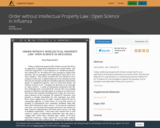
Today, intellectual property (IP) scholars accept that IP as an approach to information production has serious limits. But what lies beyond IP? A new literature on “intellectual production without IP” (or “IP without IP”) has emerged to explore this question, but its examples and explanations have yet to convince skeptics. This Article reorients this new literature via a study of a hard case: a global influenza virus-sharing network that has for decades produced critically important information goods, at significant expense, and in a loose-knit group—all without recourse to IP. I analyze the Network as an example of “open science,” a mode of information production that differs strikingly from conventional IP, and yet that successfully produces important scientific goods in response to social need. The theory and example developed here refute the most powerful criticisms of the emerging “IP without IP” literature, and provide a stronger foundation for this important new field. Even where capital costs are high, creation without IP can be reasonably effective in social terms, if it can link sources of funding to reputational and evaluative feedback loops like those that characterize open science. It can also be sustained over time, even by loose-knit groups and where the stakes are high, because organizations and other forms of law can help to stabilize cooperation. I also show that contract law is well suited to modes of information production that rely upon a “supply side” rather than “demand side” model. In its most important instances, “order without IP” is not order without governance, nor order without law. Recognizing this can help us better ground this new field, and better study and support forms of knowledge production that deserve our attention, and that sometimes sustain our very lives.
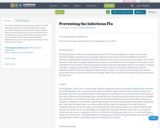
This PBL is designed for second grade students. To help understand our school and how to keep the students and staff healthy, the students will investigate different ways to prevent influenza germs from spreading. After considering each germ, they will have the opportunity to create evidence by researching and talking to different resources to come up with the best prevention method for our school.
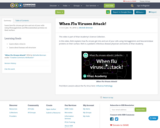
Learn how flu viruses get into and out of your cells using Hemagglutinin and Neuraminidase proteins on their surface.
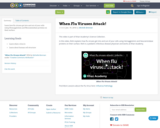
تعلُّم كيف تدخل فيروسات الإنفلونزا في خلاياكم وكيف تخرج منها باستخدام بروتينات الراصة الدموية والنورامينيداز على سطحها.